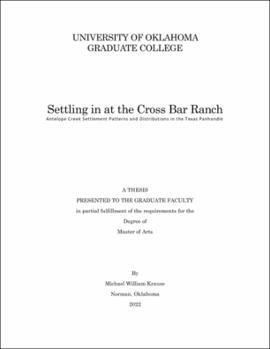| dc.contributor.advisor | Trabert, Sarah | |
| dc.contributor.author | Krause, Michael | |
| dc.date.accessioned | 2022-12-09T20:23:39Z | |
| dc.date.available | 2022-12-09T20:23:39Z | |
| dc.date.issued | 2022 | |
| dc.identifier.uri | https://hdl.handle.net/11244/336909 | |
| dc.description.abstract | Previous research conducted by Dr. Christopher Lintz into the settlement patterning of Antelope Creek groups in the southern Great Plains found that those settlements could be typified according to their site function, and further delineated through specific environmental preferences and architectural styles. The purpose of this examination is to assess the validity of Lintz’s Antelope Creek settlement model using more recent spatial statistics and other GIS analyses, while also testing his model within a study area different from his own. Specifically investigated is the relationship between various sites and their local ecological preferences, as well as plausible associations between sites sharing a close proximity. In particular, environmental elements such as elevation, degree of slope, distance and access to potable water, flora/fauna diversity, soil composition, and topographic setting are compared between Lintz’s site typologies of subhomesteads and homesteads within an area of the Texas panhandle known as the Cross Bar Ranch. | en_US |
| dc.language | en_US | en_US |
| dc.subject | Anthropology | en_US |
| dc.subject | Settlement Patterning | en_US |
| dc.subject | Antelope Creek | en_US |
| dc.title | Settling in at the Cross Bar Ranch: Antelope Creek Settlement Patterns and Distributions in the Texas Panhandle | en_US |
| dc.contributor.committeeMember | Bethke, Brandi | |
| dc.contributor.committeeMember | Livingood, Patrick | |
| dc.contributor.committeeMember | Randall, Asa | |
| dc.date.manuscript | 2022-12-07 | |
| dc.thesis.degree | Master of Arts | en_US |
| ou.group | Dodge Family College of Arts and Sciences::Department of Anthropology | en_US |
